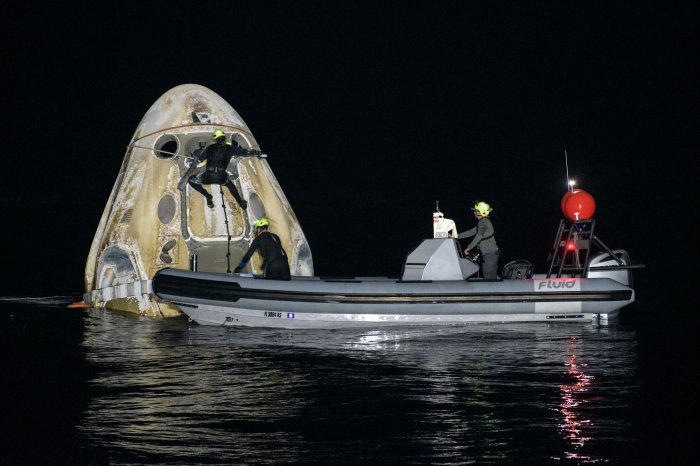1 of 3 | NASA astronauts Megan McArthur and Shane Kimbrough (front left and right) walk to their rides to the launch pad at Kennedy Space Center in Florida on April 23 with ESA astronaut Thomas Pesquet and JAXA Astronaut Akihiko Hoshide (from left, rear). File Photo by Joe Marino/UPI |
License Photo
ORLANDO, Fla., May 26 (UPI) -- The European Space Agency wants to recruit the first astronaut with a significant physical disability as one way to broaden the pool of talent for space exploration.
The agency, which includes 22 European nations, has received hundreds of applications for its new Parastronaut Project and hopes to name one or a few astronauts from that pool by April 2022, said Guillaume Weerts, ESA's space medicine team leader.
Since the program is considered experimental, no specific mission or launch date has been determined. And not every disability would qualify.
"This is very new, so there are some disabilities that cannot be accommodated in space at this time," Weerts said. "But we want people who can participate in a successful mission as much as possible."
The agency has narrowly defined the disabilities it can accommodate by making minor adjustments to training requirements, spacesuits and spacecraft systems, he said.
Those who could qualify, ESA officials said, are are people without a lower leg, those who have one leg shorter than the other and adults under 4 1/4 feet tall.
The program is open to citizens of ESA's member states, which range from tiny nations like Estonia on the Baltic Sea to larger economic powerhouses like Germany and the United Kingdom.
Other selection criteria are the same academic, personal and career standards as the historic astronaut program, which ESA began in 1977.
ESA astronauts fly regularly on NASA missions that launch from Florida and on Russian missions from Kazakhstan to the International Space Station. Weightlessness in space would minimize problems with lower extremities, Weerts said.
However, he added that spaceflight also includes launching, landing and possible emergency evacuations, among other situations, that could require functioning leg mobility.
Making accommodations for a disabled person will help ESA, NASA and others to better understand physical mobility issues in space, he said.
"It will be very, very informative," Weerts said. "For example, during a lengthy mission to Mars that could last months or a year, someone could have an accident and become disabled, so we should know more about this."
NASA supports the program and all efforts to broaden the pool of talent that the astronaut program can draw from, the space agency said in a statement.
"NASA applauds ESA's emphasis on diversity and inclusion for its para-astronaut selection process and program," the statement said. "We look forward to working inclusively and leveraging the full diversity of ESA and all our partners to make space available for everyone."
ESA consulted with paralympic organizations before developing the program, said David Parker, the agency's head of human and robotic exploration. He said he pushed for the Parastronaut Project over the past few years.
Groups that provide help and support for disabled people have cheered the idea.
Including disabled people in all professions is critical to ensuring equity and parity in such sectors, said Shuan Butcher, communications manager for Maryland-based Move United, a non-profit organization that provides adaptive sports opportunities to thousands of youths and adults.
"When it comes to humanity and intersectionality, we must realize that we are not defined by a single characteristic," Butcher said in an email. "Having a disability doesn't disqualify you. That is why our work is focused on shifting the narrative from disabled to 'this abled.'"
ESA and other space agencies have discussed ways to include people with disabilities for years, Parker said.
"We do all our spaceflight activity on behalf of humanity, and we can't claim that anymore if we aren't including people that are representative of society as a whole," he said.
"We're steering a fine line between the expectations we're creating and the uncertainty of the outcome."
Support teams work around the SpaceX Crew Dragon Resilience spacecraft shortly after it landed with NASA astronauts Mike Hopkins, Shannon Walker and Victor Glover and Japan Aerospace Exploration Agency astronaut Soichi Noguchi aboard in the Gulf of Mexico off Panama City, Fla., on Sunday. Photo by Bill Ingalls/NASA |
License Photo
















